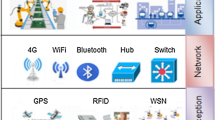Abstract
The proposed outlier detection scheme is multi-filtered, outlier stage outlier detection approach for resource constrained devices and networks. Multi-filtered consists of detection using trust, indices and performance based outliers whereas multi-stage detection detect outliers at MAC, routing and application layer. A novel trust management mechanism is proposed for trust based outlier detection followed by internal and external indices for second stage filtering and outlier detection. Thereafter, performance of individual and group nodes is measured for outlier detection and subsequent processing. Simulation results shows cluster stability with different number of clusters. Maximum stability for 0 to 500 nodes (small scale network) is observed with 25 clusters, 500 to 3000 nodes (medium scale network) is observed with 39 clusters and 3000 to 5000 nodes (large scale network) is observed with 52 clusters. The proposed approach shows cluster stability of 61% (approax.).
Access this chapter
Tax calculation will be finalised at checkout
Purchases are for personal use only
Similar content being viewed by others
References
Cluster Validation Statistics: Must Know Methods - Articles - STHDA. http://www.sthda.com/english/articles/29-cluster-validation-essentials/97-cluster-validation-statistics-must-know-methods/. Accessed 05 Jul 2018
Brock, G., Pihur, V., Datta, S., Datta, S.: clValid : an R package for cluster validation. J. Stat. Softw. 25(4), 1–22 (2008)
Charrad, M., Ghazzali, N., Boiteau, B., Niknafs, A.: NbClust: an R package for determining the relevant number of clusters in a data set. J. Stat. Softw. 61(6), 1–8 (2014)
Theodoridis, S., Koutroumbas, K.: Pattern Recognition. Academic Press, Cambridge (2009)
Rousseeuw, P.J.: Silhouettes: A graphical aid to the interpretation and validation of cluster analysis. J. Comput. Appl. Math. 20, 53–65 (1987)
Dunn, J.C.: Well-separated clusters and optimal fuzzy partitions. J. Cybern. 4(1), 95–104 (1974)
Davies, D.L., Bouldin, D.W.: A cluster separation measure. IEEE Trans. Pattern Anal. Mach. Intell. (1979)
Caliñski, T., Harabasz, J.: A dendrite method foe cluster analysis. Commun. Stat. 3, 1–27 (1974)
Moulavi, D., Jaskowiak, P.A., Campello, R.J.G.B., Zimek, A., Sander, J.: Density-based clustering validation. In: Proceedings of the 2014 SIAM International Conference on Data Mining (2014)
Evaluation of clustering. https://nlp.stanford.edu/IR-book/html/htmledition/evaluation-of-clustering-1.html#fig:clustfg3. Accessed 05 Jul 2018
Liu, Y., Li, Z., Xiong, H., Gao, X., Wu, J., Wu, S.: Understanding and enhancement of internal clustering validation measures. IEEE Trans. Cybern. 43, 982–994 (2013)
Kovács, F., Legány, C., Babos, A.: Cluster validity measurement techniques. In: 5th WSEAS International Conference on Artificial Intelligence, Knowledge Engineering and Data Bases, pp. 388–394 (2006)
Huang, S., Cheng, Y., Lang, D., Chi, R., Liu, G.: A formal algorithm for verifying the validity of clustering results based on model checking. PLoS One 9(3), e90109 (2014)
Gurung, S., Chauhan, S.: A dynamic threshold based approach for mitigating black-hole attack in MANET. Wirel. Netw. 1–15 (2017)
The Network Simulator - ns-2. https://www.isi.edu/nsnam/ns/. Accessed 05 Jul 2018
Van Craenendonck, T., Leuven, K., Blockeel, H.: Using internal validity measures to compare clustering algorithms. In: ICML, pp. 1–8 (2015)
Panos, C., Xenakis, C., Stavrakakis, I.: A novel intrusion detection system for MANETs. In: Proceedings of the 2010 International Conference on Security and Cryptography (SECRYPT), pp. 1–10 (2010)
Feng, F., Liu, X., Yong, B., Zhou, R., Zhou, Q.: Anomaly detection in ad-hoc networks based on deep learning model: a plug and play device. Ad Hoc Netw. 1–9 (2018)
Rafsanjani, M.K., Movaghar, A., Koroupi, F.: Investigating intrusion detection systems in MANET and comparing IDSs for detecting misbehaving nodes. World Acad. Sci. Eng. Technol. 44(1), 351–355 (2008)
Li, Y. and Wei, J.: Guidelines on selecting intrusion detection methods in MANET. In: Proceedings of the Information Systems Educators Conference, pp. 10:30–10:55 (2004)
Anantvalee, T., Wu, J.: A survey on intrusion detection in mobile ad hoc networks. In: Wireless Network Security, pp. 159–180 (2007)
Narayandas, V., Tiruvayipati, S., Hanmandlu, M., Thimmareddy, L.: Anomaly detection system in a cluster based MANET. In: Computer Communication, Networking and Internet Security, pp. 11–21 (2017)
Sánchez-Casado, L., Maciá-Fernández, G., García-Teodoro, P., Magán-Carrión, R.: A model of data forwarding in MANETs for lightweight detection of malicious packet dropping. Comput. Netw. 87(1), 44–58 (2015)
Kumar, A., Gopal, K., Aggarwal, A.: Novel trust hierarchical construction for RFID sensor-Based MANETs using ECCs. ETRI J. 37(1), 186–196 (2015)
Kumar, A., Gopal, K., Aggarwal, A.: A novel lightweight key management scheme for RFID-sensor integrated hierarchical MANET based on internet of things. Int. J. Adv. Intell. Paradig. 9(2–3), 220–245 (2017)
Acknowledgement
The authors would like to thank SEED Division of University of Petroleum and Energy Studies. This work is part of research project (https://sites.google.com/view/adarshproject2/) sponsored by University of Petroleum and Energy Studies (UPES), Dehradun, India under Grant: UPES/R&D/180918/14.
Author information
Authors and Affiliations
Corresponding author
Editor information
Editors and Affiliations
Rights and permissions
Copyright information
© 2020 Springer Nature Switzerland AG
About this paper
Cite this paper
Kumar, A., Aggarwal, A. (2020). An Efficient Outlier Detection Mechanism for RFID-Sensor Integrated MANET. In: Abraham, A., Cherukuri, A.K., Melin, P., Gandhi, N. (eds) Intelligent Systems Design and Applications. ISDA 2018 2018. Advances in Intelligent Systems and Computing, vol 940. Springer, Cham. https://doi.org/10.1007/978-3-030-16657-1_80
Download citation
DOI: https://doi.org/10.1007/978-3-030-16657-1_80
Published:
Publisher Name: Springer, Cham
Print ISBN: 978-3-030-16656-4
Online ISBN: 978-3-030-16657-1
eBook Packages: Intelligent Technologies and RoboticsIntelligent Technologies and Robotics (R0)




